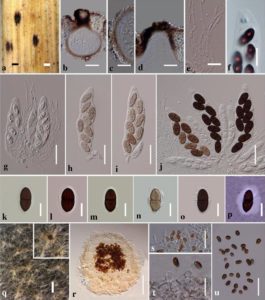Cainia globosa Senan., Camporesi & K.D. Hyde, in Hyde et al., Fungal Diversity 80: 201 (2016)
Index Fungorum number: IF 552136, Facesoffungi number: FoF 02461
Etymology – In reference to the globose ascospores.
Saprobic on standing culms of Anthoxanthum odoratum L. Sexual morph Ascomata 250–360 μm high 9 210–315 μm diam. (x = 326 × 264 μm , n = 10), solitary to scattered, immersed beneath clypeus, dark brown to black, globose to subglobose, uniloculate, coriaceous, with a central ostiole. Peridium 20–25 μm wide, composed of inner, thick-walled, compressed, hyaline cells of textura angularis and outer, dark brown to black cells of textura angularis. Hamathecium comprising 3–4 μm wide, septate, guttulate, sometimes branched, hyaline paraphyses. Asci 175–190 9 40–50 μm (x = 188 × 46 μm , n = 20), 8-spored, unitunicate, cylindric-clavate, straight, short pedicellate, with a layered, apical ring, bluing lightly in Melzer’s reagent. Ascospores 30–35 × 14–17 μm (x = 33 9 16 μm , n = 20), uni-seriate, ellipsoid to oval, rounded at both ends, hyaline when immature, becoming pale brown to dark brown when mature, medianly 1-septate, not constricted at the septum, guttulate when immature, striate, surrounded by a mucilaginous sheath. Asexual morph Conidiomata pycnidial, superficial, solitary, formed at the colony margins. Conidiophores reduced to conidiogenesis cells. Conidiogenous cells 4–7 × 1.5–3 μm , (x = 5.5 × 2.4 μm ), holoblastic, cylindrical, hyaline, unbranched, septate. Conidia 7–10 × 3.5–5 μm (x = 8 × 4.4 μm , n = 20), globose to oval, 0–1-septate, brown, striate.
Culture characteristics – Colonies on MEA reaching 2 cm after 14 days at 18 ºC, circular, dense, white, velvety, radiating towards the slightly undulate edge, not pigmented, after 4 weeks, small superficial, pycnidia formed mainly at margin of the colonies.
Material examined – ITALY, Province of Forlı`-Cesena, Santa Sofia, near San Paolo in Alps, on dead culms of Anthoxanthum odoratum (Poaceae), 2 May 2013, E. Camporesi, IT 1217 (MFLU 14-0738, holotype), ex-type living culture, MFLUCC 13-0663.
Notes – Cainia globosa is morphologically distinct from other species in having ascospores with small guttules in each cell, very lightly bluing bi-lobed apical ring and 1-septate, striate conidia. Cainia globosa clustered together with C. graminis and C. anthoxanthis. However, C. globosa separates from these species with high support (85/ 0.9). The asexual morph of Cainia observed from a pure culture of C. desmazieresii was reported by Müller and Corbaz (1956) as Rhabdospora-like. However, Krug (1978) was unable to obtain the asexual morph from C. desmazieresii in culture (Kang et al. 1999). Here we observed a coelomycetous asexual morph from the culture.

Fig 1 – Cainia globosa (MFLU 14-0738, holotype). a Appearance of ascomata on host substrate as minute clypeate ostiolar dots. b Section through ascoma. The blackened clypeal area is narrow. c Peridium. d Papilla. e Pseudoparaphyses. f Ascus in Melzer’s reagent showing lightly bluing apical apparatus. g–j Immature and mature unitunicate ascospores in asci. k–o Ascospores. p Mucilaginous sheath. q Conidiomata on MEA. r Cross section of conidiomata. s, t Conidiogenous cells with conidia. u Conidia. Scale bars a, q, r = 200 μm , b = 100 μm , c, d, g–j, s–u = 50 μm , e, f, k–p = 20 μm.
